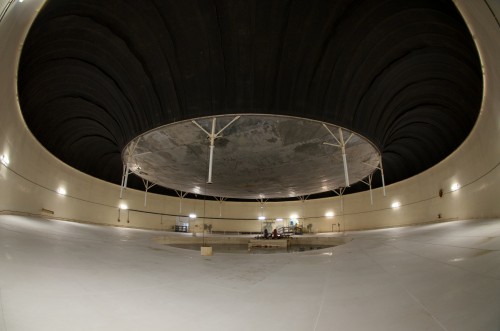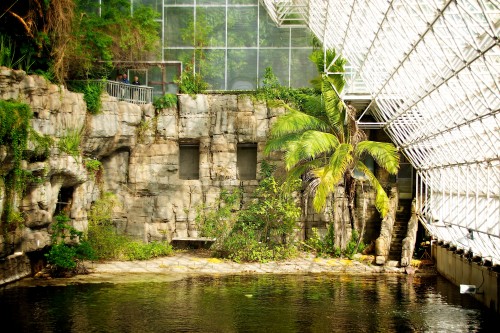 I’m writing to you from inside an artificial lung. Really.
I’m writing to you from inside an artificial lung. Really.
I’m sitting at a desk in a cylindrical, windowless room, 180 feet across. The floor and walls are concrete, and the ceiling, several stories above, is rimmed with an enormous black rubber gasket which sighs gently—up, then down—every time somebody opens the door.
No one has opened the door for quite a while now, and the quiet is thick. I’m pretty happy about that.
I’m in the basement of Biosphere 2, a three-acre glass-and-steel greenhouse on the north edge of Tucson, Arizona. The brainchild of environmentalist and oil-fortune heir Edward Bass, Biosphere 2 is most famous for its failures: In the fall of 1991, eight men and women gamely sealed themselves inside, planning to grow all their own food, recycle their air and water, and otherwise live without outside support. The follies that ensued have been recounted many times elsewhere, but let’s just say that in 1994, after two extremely glitchy missions, the Biospherans parted as something less than friends. (It may have had something to do with the fact that they could only grow enough beans for one round of coffee every two weeks.)
For years afterward, the building passed from institution to institution. Its infrastructure decayed, and its swimming-pool-sized artificial ocean turned murky with algae. But a large, climate-controlled environment is a handy place for experiments—in fact, scientists did some important early research on ocean acidification at Biosphere 2—and when the University of Arizona adopted the building in 2007, earth and climate scientists revived it as a laboratory. Today, tourists hear two stories from their guides: the heroic farce enacted by the early Biospherans, and the heroic resurrection-in-progress led by present-day researchers.
As I write this, tourists are peering at another Biosphere display: me. Eric Magrane, a University of Arizona doctoral student in geography, was curious about the Biosphere’s presentation of science as tourist attraction, and he wondered how art—the practice of art, that is—would fare in comparison. With the cooperation of the Biosphere, he invited several poets and writers to spend the day inside, publicly deploying our craft within a succession of different Biosphere habitats.
A chance to write inside a fake planet? I wasn’t about to say no.
My first hour-long shift was at the beach. I eagerly took my place behind the desk, noticing the green, moist smell of the tropical plants, the  sun shining through the slanted glass panels above, and the rhythmic, soothing sound of the wave machine. Wave machine … uh-oh. Within ten minutes I was asleep. Great, I thought when I awoke. The only thing duller than watching a writer write is watching a writer sleep.
sun shining through the slanted glass panels above, and the rhythmic, soothing sound of the wave machine. Wave machine … uh-oh. Within ten minutes I was asleep. Great, I thought when I awoke. The only thing duller than watching a writer write is watching a writer sleep.
I moved on to the fog desert habitat, where I did what I usually do in any desert. I lay on a rock and thought about things. I did think about a writing problem—for a few minutes. I also thought about how I’d told my husband that I would be demonstrating my writing process in public, and he’d replied, “Oh, really? The part where you check Facebook, or the part where you stand in front of the refrigerator in your socks?”
This, I thought, was not going so well.
Finally, I was led down a sloping steel tunnel and into the south lung, one of the two chambers that were used to equalize interior and exterior air pressure during the Biosphere missions. Here, I did what I usually do when I put myself in a quiet, predictable space. I wrote.
I wrote several pages about a fictional character I’ve been trying to figure out, and then I started to write this post. A tour group came by, but I just kept writing. Soon, I imagine, I’ll hear a single set of footsteps echo in the tunnel, and Eric will arrive to lead me back to sunlight and company. Which will be delightful, but a little sad, too.
What I’ve learned from Eric’s experiment is something that he and most of us writers already know. Some parts of the writing process—like some parts of the scientific process—can be performed, but the most important and interesting parts can never go on display.
If I were feeling charitable, I’d say that my nap on the beach and my daydreaming in the desert were part of my process, in that they gave me the material for this post. Mostly, though, I was just screwing around, apparently waiting until I could disappear into a giant concrete hatbox and start the difficult, exciting, annoying and addictive process of turning thoughts into words. We writers may have different ways of getting to the habitat that matters most, but every route leads us to the same place—and that place lies right between our ears.
Photos of the artificial lung and the soporific beach courtesy of Paul Ingram at Biosphere 2.
Great piece! As a musician-turned-writer, I often miss the performance aspect of being creative and wish there were more ways to engage live with the audience (and other writers!).
Cool opportunity, Michelle! It reminds me a bit of Oryx and Crake, with tourists wandering by to observe the Crakers in their engineered “natural” environment…Atwood would’ve probably fallen asleep, too.